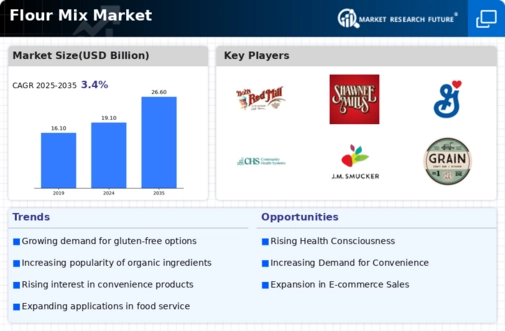E-commerce Growth
The Flour Mix Market is experiencing a notable shift due to the rapid growth of e-commerce platforms. As consumers increasingly turn to online shopping for convenience, the demand for flour mixes available through digital channels is rising. Market data reveals that online grocery sales have surged, with a significant portion of consumers preferring to purchase food products online. This trend is prompting manufacturers and retailers to enhance their online presence and optimize their distribution strategies. The Flour Mix Market may see an increase in direct-to-consumer sales, allowing brands to engage more effectively with their customers. As a result, the industry is likely to adapt to the evolving retail landscape, focusing on digital marketing and e-commerce strategies to capture a larger market share.
Sustainable Practices
Sustainability is becoming a pivotal driver in the Flour Mix Market, as consumers increasingly favor products that are environmentally friendly. This shift is prompting manufacturers to adopt sustainable sourcing practices, such as using organic grains and reducing carbon footprints in production processes. Market data suggests that the demand for sustainably produced food products is on the rise, with a notable increase in sales of organic flour mixes. Companies that prioritize sustainability are likely to enhance their brand image and attract environmentally conscious consumers. Furthermore, the Flour Mix Market may witness collaborations between producers and agricultural sectors to promote sustainable farming practices, thereby ensuring a steady supply of raw materials while minimizing environmental impact.
Convenience and Versatility
The Flour Mix Market is significantly shaped by the growing consumer preference for convenience and versatility in food preparation. As lifestyles become busier, there is an increasing demand for products that simplify cooking and baking processes. Flour mixes that offer easy-to-use solutions, such as pre-measured ingredients or all-in-one mixes, are gaining traction. Market analysis indicates that the convenience food sector is expanding, with flour mixes being a key component. This trend is likely to drive innovation in product development, as manufacturers seek to create flour mixes that cater to diverse culinary applications, from baking to cooking. Consequently, the Flour Mix Market is expected to evolve, focusing on products that not only save time but also deliver quality results.
Health-Conscious Formulations
The Flour Mix Market is increasingly influenced by the rising demand for health-conscious formulations. Consumers are becoming more aware of the nutritional content of their food, leading to a preference for flour mixes that incorporate whole grains, gluten-free options, and added nutrients. This trend is reflected in market data, which indicates that the health and wellness segment is projected to grow significantly, with a compound annual growth rate of approximately 7% over the next five years. Manufacturers are responding by innovating their product lines to include organic and fortified flour mixes, catering to the needs of health-oriented consumers. As a result, the Flour Mix Market is likely to see a shift towards products that not only meet taste preferences but also align with dietary requirements, thereby expanding the consumer base.
Culinary Trends and Innovations
Culinary trends and innovations are playing a crucial role in shaping the Flour Mix Market. As consumers become more adventurous in their cooking, there is a growing interest in unique flavors and ethnic cuisines. This trend is prompting manufacturers to develop specialized flour mixes that cater to specific culinary needs, such as Asian or Mediterranean cooking. Market data indicates that the demand for specialty flour mixes is on the rise, with consumers willing to pay a premium for unique and authentic flavors. This evolution in consumer preferences is likely to encourage continuous innovation within the Flour Mix Market, as companies strive to differentiate their products and meet the diverse tastes of consumers.




















Leave a Comment